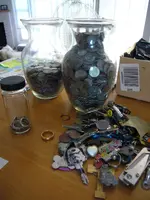ok so-cal-beach-scanner, I found your first post and read it. Great pix. Nice rings.
To answer some of your questions about how there can be good zones, that you would *THINK* the other long-time local md'rs would be harvesting (including the people you saw): Here's a few ideas:
a) On southern CA beaches, pulse machines are very popular amongst the most hardcore there. They go super deep (deeper than your at-pro), find the finest daintiest of chains and earing studs, and will cut right through the nastiest of minerals. Hence, "how can you argue with that?" right? But the downside of those machines is, they can't discriminate out nails (especially bent ones).
b) so those pulse users tend to avoid the junky nail-ridden areas, and gravitate to cleaner areas void of nails. Thus yes, if someone with a discriminator goes into junky areas, then yes, you're often in an area the pulse machine users avoid.
c) A lot of hardcore beach hunters simply bristle at hunting the dry sand to begin with. And here's why: if you ever got into some thick wet-sand erosion action, you too would be spoiled to the point, that you too would never return to dry sand hunting again. I detest dry sand hunting (but do it on occasion to kill time). EVEN THOUGH .... just like your experience .... I know places where I can go right now and dig 50 to 100 clad coins if I cared to. But it's much more fun to let mother nature do the work for you, and study the tides/winds/swells to arrive at the eroded spots on the beach. When that happens in the right fashion, you can "kiss aluminum (yes, even the molten blobs) goodbye". Because all the light stuff is taken out to the ocean, leaving the heavy items behind on mother nature's natural sluice box/riffle board.
Kinda hard to get excited about dry sand hunting, if you've ever been in action so thick that you're averaging 100 coins per hour (essentially as fast as you care to dig, multiple beeps per swing). Also when erosion is good and deep, old coins can surface (and it's rare to get old coins in the dry sand).
The downside of that is, granted, those type erosion conditions don't occur that often.
d) yes, some beginner hunters down there are downright sloppy and inexperienced (don't go deep, don't dig whispers, have lousy machines, etc...)
Hence the reason why sometimes there's seemingly un-tapped zones in the dry sand.
Not sure what you're talking about the water temperature and/or people not swimming. I thought So. CA beaches (everything south of Santa Barbara) was famous for having quite tolerable (nearly bath-tub temperatures?) for swimming with no wet-suit. On a good hot summer day on popular beaches there, it's not uncommon to see hundreds of people in the water. And sure, some rings are going to be too far off-shore to get without wading/scuba. But a heck of a lot are in the ebbing-inter-tidal zone (where the next minus tide avails you of those exact regions).
In any case, the fact of warm waters that people actually swim in, bodes another reason for an increased ratio of rings even in the dry-sand on such beaches: People take off their jewelry for "safe-keeping" before they go in for a dip. You know, hide it in their shoe, or hand it to their kid or husband to hold on to while the go frolick. This is a common reason you read about when someone's got a lost-jewelry ad, is they had taken on their jewelry, hid it in their cup or shoe, etc... So I would think that So. CA beaches, even on the dry sand, if the target counts got high enough, that there should eventually be rings in the mix.
Contrast to beaches where I'm at (Monterey Bay), you will turn blue if you try to swim w/no wetsuit at most of them

Some of the dumpy "locals" (no tourist) beaches here, I have got 500+ coins before getting a gold ring, even on the wet sand after storms. The touristy beaches are better though, for ring-to-coin ratios.






 Some of the dumpy "locals" (no tourist) beaches here, I have got 500+ coins before getting a gold ring, even on the wet sand after storms. The touristy beaches are better though, for ring-to-coin ratios.
Some of the dumpy "locals" (no tourist) beaches here, I have got 500+ coins before getting a gold ring, even on the wet sand after storms. The touristy beaches are better though, for ring-to-coin ratios.
